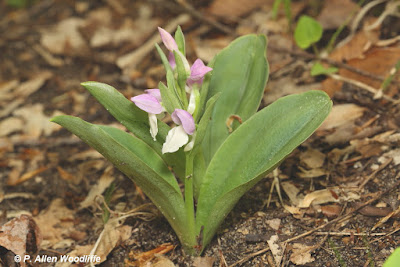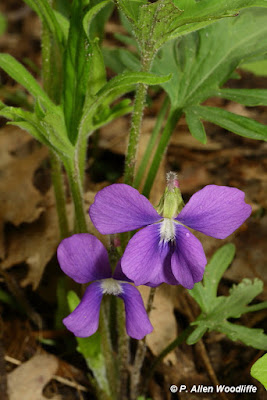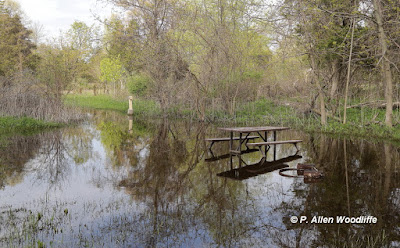It was very quiet this last full week of May, partly due to the decline in bird action, and also birders, but also because the Rondeau campground remained closed due to flooding! No campers on the holiday weekend or during the week made the atmosphere somewhat eerie compared to what one would normally expect. Some roads and campsites were relatively okay.
Other roads clearly were not, as they were flooded for several hundred metres.
Some campsites were definitely not okay....this is what some campsites looked like as campers were being moved out of the park. Imagine trying to hook up or unhook the electrical cord having to wade through half a metre of water as some did, and with the hydro pedestal surrounded by water. Note also the top of the fire pit just to the right of the picnic table, barely sticking above the water!
Such is the situation of a dynamic shoreline/sandpit with an alternating ridge and slough topography being affected by extremely high lake levels, strong SE winds and torrential rain (~10 cm in 5-6 days). Rumour has it that the campground might be open, or at least partially open, by the first of June.
But the bird migration went on regardless of the difficulties that us earth bound mortals had to face. The spring migration of forest type birds has peaked, it seems, and that is as it should be. The majority of birds one now sees in forest settings are here to nest and raise the next generation if they can successfully overcome the obstacles in doing so (weather, food supply, predators, etc). A recent visit to Rondeau resulted in seeing mostly individuals of species known to nest.
A species that always gets a lingering look, is the male Scarlet Tanager. It doesn't nest abundantly, but in small and scattered numbers here.
Rose-breasted Grosbeaks are more common than they were a few years ago. They like a little more open forest, and that has certainly been the case at Rondeau with some severe storms causing blowdowns and therefore canopy openings which results in a younger generation of trees. The onslaught of the Emerald Ash Borer has contributed as well. I noted a female grosbeak with a mouth full of nesting material heading to a likely spot on my last visit. It seems this species only arrived in southwestern Ontario a week or ten days ago, and they haven't lost any time in getting right into nesting mode.
 |
| Male Rose-breasted Grosbeak |
Yellow Warblers are by far the most abundant breeding warbler in southwestern Ontario. It seems that at a place like Rondeau, you are always in a territory of a pair! And if you linger, either the male or female will chip in angst hoping you will move on. On one occasion I ended up in the middle of a territory while the female, noted below, had a mouth full of nesting material. She was able to express her concern in spite of the mouth full.
The Wood Thrush has a pleasing, melodious flute-like song. It is especially noticeable on a calm morning, and on occasion one can get a glimpse of the songster through a gap in the low shrubby vegetation.
In a forest opening, or at the edge, one hears the next species on a regular basis. Seeing it in the shade, as shown in the following photo, does not immediately give away its real identity.
If it moves to a slightly sunnier location even on the same branch, as this one did, it is more apparent. It is the Indigo Bunting.
If you see it in bright sunlight one can get an appreciation for its vibrant blue colour. It is interesting that the colour is not the result of pigment in the feathers. Rather it is the result of physics: it is the way the feathers cause the refraction of the direct sunlight which gives the bright blue, and therefore the reason why it looks dull black in heavy shade.
Eastern Kingbirds are often seen in relatively wide open spaces.
Common Yellowthroat is more often heard than seen. It skulks in grassy shrubby edges of forest, field and marsh.
There are a few later migrants still trickling through, such as some of the flycatchers and even the later warbler species. Bay-breasted Warblers are a later species and it was not unusual to see a dozen or more on recent visits.
I heard, but did not see, a Connecticut Warbler. They are one of the ultimate skulkers in shrubby forest vegetation, it seems.
Philadelphia Vireos do not nest here either, but are more often seen towards the end of the migration peak rather than the early part.
 |
| Philadelphia Vireo |
Flycatchers are fairly abundant now. Unfortunately unless they are singing and you can hear them clearly, they are sometimes difficult to identify. The amount of olive green colour is a useful identification feature, but when they are in the greenery of the developing forest vegetation as in the next photo, it isn't all that useful. Hence conservative identification just lists them as an
Empidonax, which is the genus of Willow, Alder, Least, Yellow-bellied and Acadian, all of which occur regularly in varying numbers
This next one may be a Willow Flycatcher.
Because you can see a bit more detail on the front of this next one, it is very likely a Yellow-bellied Flycatcher.
Of course when you are looking up into the trees for birds, you sometimes come across non-bird forms of wildlife. An Eastern Grey Squirrel is chowing down on some newly developed oak flowers.
This Eastern Chipmunk was involved in a territorial dispute with a neighbour, but paused long enough for a photo.
I startled this one around the corner of a building. I can't recall seeing a chipmunk climbing the brick walls of a building before. It clearly was not comfortable with the idea either. On a couple of occasions in its efforts to scamper away, it lost its footing and almost took a tumble to the ground.
Shorebirds, on the other hand, have a lot farther to go since many of them will be migrating to the high arctic and sub-arctic areas which may not be free and clear of residual winter conditions. As a result, while the forest/landbirds have peaked now, the shorebirds are just entering their peak in numbers and diversity. Sewage lagoons and flooded fields are a great place to see them. This first photo shows the relative size of a small, Least Sandpiper compared to a much larger Dunlin.
This Lesser Yellowlegs is demonstrating its balancing prowess.
White-rumped Sandpipers are not common but a few show up. The white rump is not visible in this next photo, but the characteristic dark speckling along its flank is. A very close look will show the orangey base of the bill, another useful feature.
A recent highlight was to hear about a pair of Black-necked Stilts at the Blenheim lagoons. There have only been a couple of records of this species for the Rondeau checklist area that I am aware of, so it was definitely a highlight to get the word from Steve Charbonneau one early afternoon. By the time I got there a bit later, a tractor/roto-tiller was operating at the sprinkler cells, working up two of the dry cells. The activity must have spooked the stilts. At least when Garry and I got there, they were nowhere to be seen. As we were preparing to look elsewhere for them in the lagoon complex, Garry noticed them flying by. I got a couple of quick shots, thinking that was all I was going to get.

They didn't land, but headed to some other point in the complex. Garry and I searched around much of the area but came up empty. By this time, the tractor operator had finished the job and we thought it was worth checking the sprinkler cell area again, since two of the cells had suitable water levels. We didn't see them and as we were leaving, they flew in again and this time they landed. We managed to get some fairly decent photos. The male is slightly larger and has an all black back, whereas the back of the female has a brownish tinge to it, as shown in the second photo.
To add to the unusualness of the season, a Snowy Owl continued to hang out along a rural area near Pain Court, west of Chatham. This one had been seen by others on a hydro pole, but on the occasion I was by, it was lower and onthe arm of a non-operating oil drilling rig.


















































